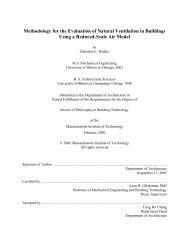CHT-08-012 Runchal_Final_Jun_08 - Cham
CHT-08-012 Runchal_Final_Jun_08 - Cham
CHT-08-012 Runchal_Final_Jun_08 - Cham
You also want an ePaper? Increase the reach of your titles
YUMPU automatically turns print PDFs into web optimized ePapers that Google loves.
He subsequently went on to invent highly useful and simple tools and techniques such as the IPSAInter-Phase Slip Algorithm, IPSA, [Spalding, 1985] for predicting multi-phase fluid flow, a simplealgorithm [Spalding, 1994] to determine the wall distance for complex geometries, (needed formany turbulence and radiation computations), a multi-fluid approach to turbulence. [Agonafer et al,1996], a multi-fluid approach for turbulent combustion [Spalding, 1996], a novel approach forintegrated radiation computations [Spalding, 1996], and a methodology to unify fluid and solidmechanics [Spalding, 2005]. He integrated all these diverse phenomena and brought them withinthe scope of CFD. All these are examples of Brian’s “physical” approach to develop practical tools.These produce approximate and plausible results even when one knows that the actual physics ismore complex but also more intractable.“Unification” has stayed the primary goal of Spalding from his Cambridge days in early 1950s tothe present. He has now added structural dynamics, turbulence and multiple phases to his plate.Brian’s approach to research is always “intuitive” and “physical” as distinct from “theoretical” or“mathematical”. He strongly believes in the “art of the possible” and is not encumbered bytheoretical limitations that may exist. The question that Brian always asks is: “Can this be useful toa practicing engineer”.SYNOPSISSo did Brian Spalding invent CFD? The answer is obviously not an unqualified yes. Origins ofCFD can be traced as far back as 1928 or perhaps even earlier. Harlow at Los Alamos, and othersin academia and research organizations, had already contributed immensely to what would laterbecome CFD. They had already explored many of the key concepts that would be used or reinventedby the IC group. Spalding did not even coin the name. Formally the name was first usedby Pat Roache [1972] in his famous book. But let us ask another question. Would there be CFD aswe know it today without Spalding? And the answer is an unqualified No. More than anyone else,he created CFD as an Engineering Tool – the application of CFD to problems of interest toengineers. Most of today’s commercially available CFD software tools trace their origin to thework done by Spalding and his group in the decade spanning 1965-1975.He was an active leader and the key contributor of novel ideas that led to the development of CFDmethodology that was efficient and “engineer-friendly”. His key insights during this decade oftenmade breakthroughs possible and re-directed the focus at critical moments. He has had over 100graduate students. Many of these students have gone on to make significant professionalcontributions in their own right. If you consider the period between 1965-1972 when both Launderand Whitelaw worked closely with Spalding, the number of students who carried the torch of “IC”methodology is truly amazing for a group under the close supervision of a single person. Many ofthese students have gone on to make a distinctive mark on the world stage. Many well-knownnames in CFD, turbulence or combustion today have a 1 st or 2 nd generation IC connection.The fact that any vector can be expressed as a rotational (vector) and irrotational (scalar)components has been known for ages. That pressure is related to the scalar component and vorticityto the vector is part of classical hydrodynamics. Harlow and Chorin independently suggested thatwe decompose velocity correction into a vector and an arbitrary scalar stage. Harlow’s group usedit to turn the continuity equation into an equation for pressure. But it was an inefficient mechanismfor steady flows – of routine interest to engineers - since it required transient solution. It took thework of Patankar and Spalding (1972) to weave it into an economical and practical tool that couldalso be used for steady flows – SIMPLE. So we can not credit Spalding for pressure projectionmethods but we should recognize the manner in which he used and turned it into a practical andviable alternative for steady state flows.-- Page 12 of 19 --
















